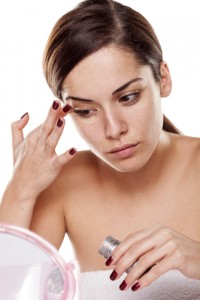Dark circles and tear troughs
 You look tired
You look tired
It’s fine if you have an air of well-earned exhaustion from a night on the tiles. When you’ve abstained from indulging, however, drunk plenty of water and had ten hours beauty sleep, being told, “you look tired”, is a pain in the proverbial.
So is there an answer beyond quality concealer and a forced smile?
What make us look most tired are dark circles around the eyes.
Dark circles affect many people and give the impression of being tired, aged and unwell when in fact you may feel positively sprightly. Although difficult to treat there are proven non-surgical methods to help to restore a fresher look. Tear trough fillers
When determining the most effective treatment, or combination of treatments, it is vital to identify the cause, of which there are many possibilities.
Aging and volume loss are the biggest offenders
Problem: Volume loss or fat descent in the cheeks, and under eye volume loss, gives form to what is commonly known as the “tear trough”. This is a depression under the eye, which creates a shadow, i.e. dark circle.
Although most people form tear troughs as a result of aging, there are some who have them as a natural deformity from a young age.
Solution: Hyaluronic Acid Filler – For volume loss and fat descent, hyaluronic acid filler is top of the pops to soften the shadow from the depression. Also known as tear trough fillers, it creates more cushioning between the paper-thin skin of the lower eyelids and deeper, dark coloured structures that further the appearance of dark circles. Strategically, this usually begins by targeting any mid facial volume loss to support a vertical lift of lower lid. The tear trough itself is then treated directly.
Hyperpigmentation
Problem: Constitutional pigment / True Pigment:
Your degree of pigment is genetic, which makes certain ethnicities with increased melanin-pigment production more susceptible, irrespective of outside factors – Black, Asian and Mediterranean skin types are examples of these.
True pigment:
Factors such as UV exposure, hormonal shifts (e.g. melasma through pregnancy or birth control) can cause pigmentation around the eyes. Also trauma (post inflammatory hyperpigmentation) from atopic eczema for example, or perfumed cosmetics can influence this.
Solution: Lightening creams – Constitutional pigment is, sadly, the hardest of all to dark circle issues to tackle and, as yet, there is no majorly satisfactory solution, However true pigment, such as melasma or sun damage can be addressed with a combination of prescription lightening creams.
Thinning under eye skin:
Eyelids present the thinnest skin on the body and with age, our skin naturally thins further. This translucent covering affords only a thin veil for the dark, underlying structures, such as the muscle and veins.
Problem: Thin skin and skin Laxity:
An ever-decreasing ability to form fresh collagen and elastin sees the skin’s support network diminish.
Solution: Microneedling – If skin laxity is the issue, a course of Dermaroller will help stimulate an abundance of growth factors to fortify the skin’s supportive mesh of collagen and elastin, strengthening and tightening the area.
Problem: Bulging under eye fat:
With age, bone reabsorption speeds up and with an enlarged eye orbit, the fat in which the eyeball resides herniates downwards and outwards.
Solution: Whilst some cases may be masked with filler, in the main, bulging under eye fat and extreme skin laxity is best dealt with surgically.
Lifestyle
Whilst everyone needs their vices, unfortunately there are some (personally controllable) factors that will lend themselves fiendishly well to dark circles:
Smoking:
Smoking causes vascular problems, constricting the blood vessels, resulting in poor circulation and making the blood vessels appear darker and more prominent.
Sleep deprivation:
Lack of sleep can create paler, more translucent skin, illuminating the vessels below.
Caffeine and alcohol consumption:
Too much caffeine and alcohol will lead to dehydration, causing blood vessels to become swollen. It will also lessen one’s ability to sleep.
Dietary deficiencies:
Dark circles (in conjunction with other symptoms) may be a sign of iron-deficiency anaemia, for example. In the majority of cases, eating the right foods or supplements may treat dietary deficiencies.
Other causes
- Allergies or nasal congestion, inflaming and enlarging the under eye vessels.
- Some medical conditions (such as thyroid or liver problems)
- Some medications (such as meds for high blood pressure)
Light based therapies (not available through Lucy Banks)
C02 Laser – This is another effective treatment for skin laxity, smoothing and tightening then skin of the upper and lower eyelids. The laser energy is absorbed by water in the deep layers of the skin’s dermis, causing the collagen to remodel and contract, which improves texture and tone. In addition, the outer layers of skin will peel following the procedure, which helps to eliminate brown spots and superficial fine lines.
Q-Switched Laser – Pigmentation may be addresses by delivering an intense beam of light to specifically target the melanin that causes pigmentation. The light is then absorbed and converted into heat, which either disperses the group of melanin cells or destroys the cells carrying the pigment molecule.
For pigmentation, laser would always be recommended as treatment secondary to peels or creams, as there is greater risk-benefit ratio and multiple treatment sessions are required.